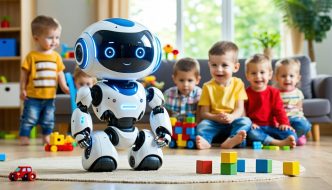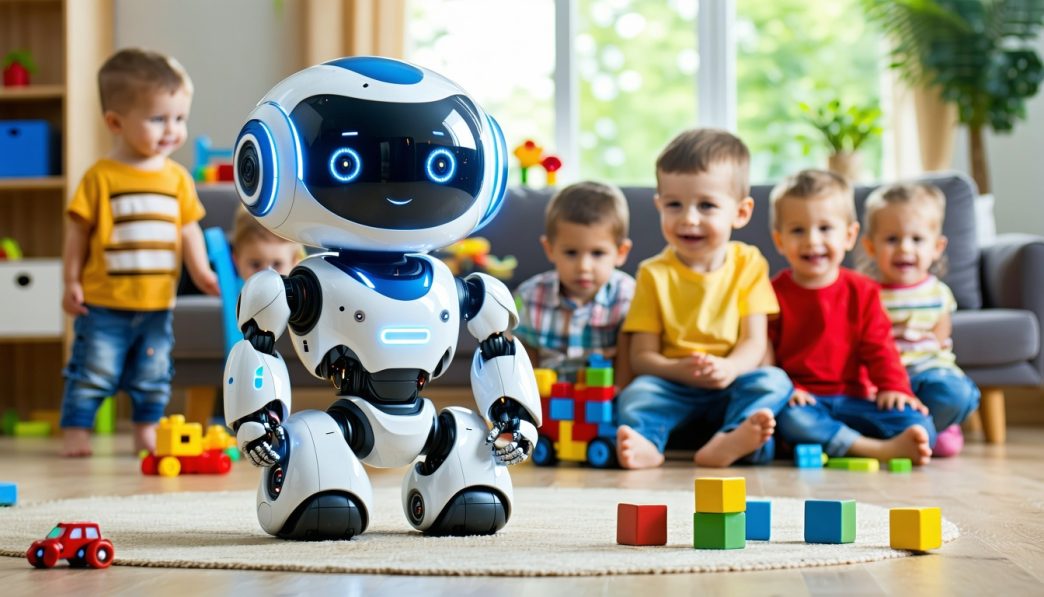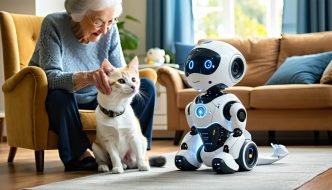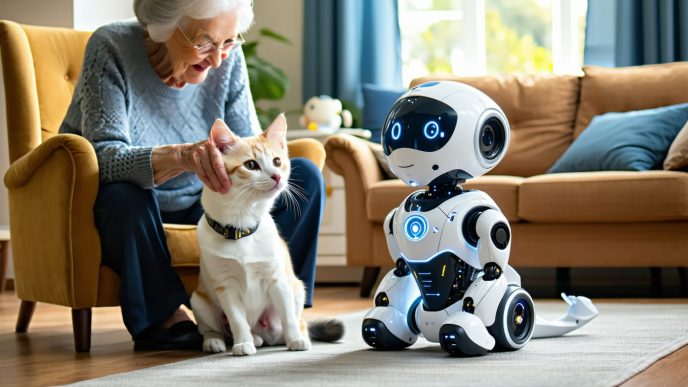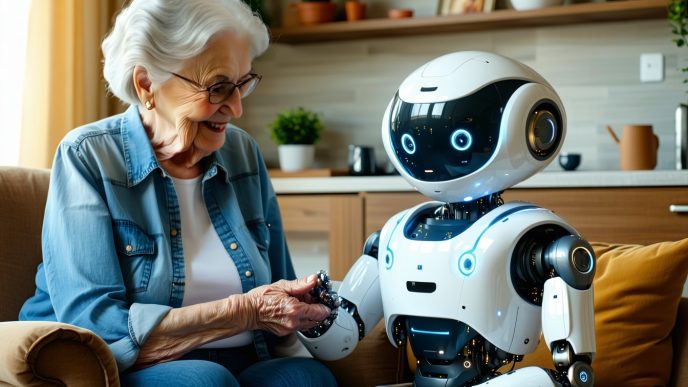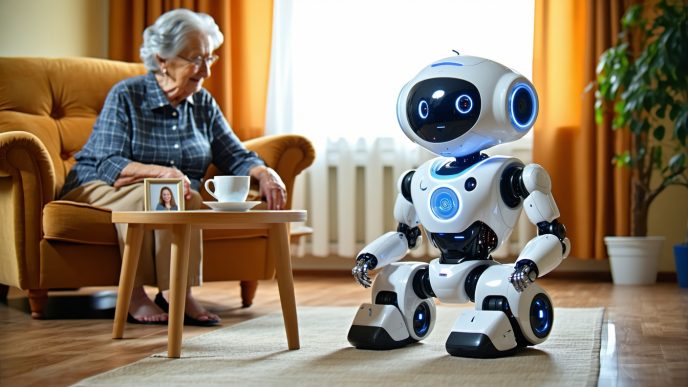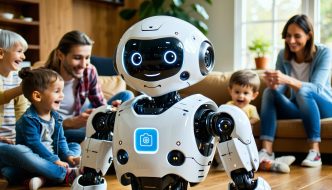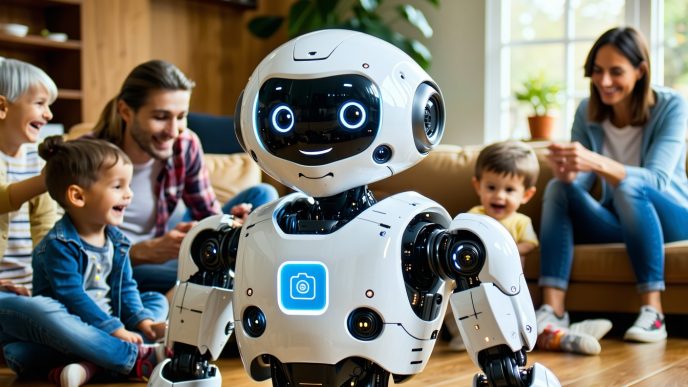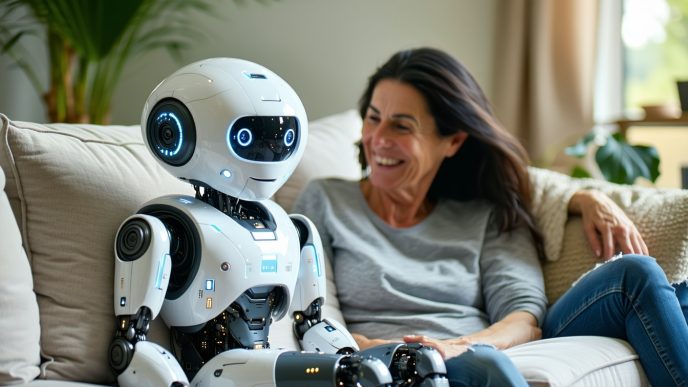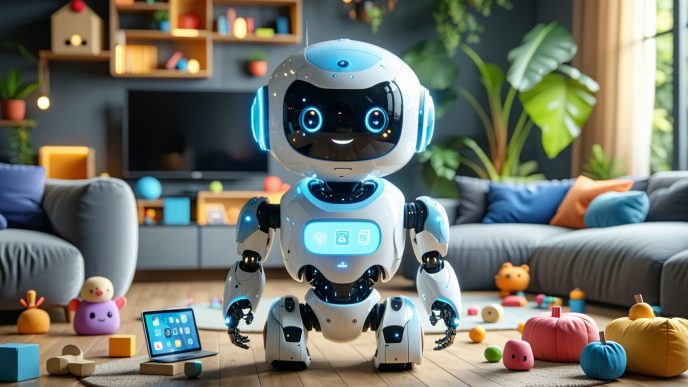Introduction to Companion Robots for Children
Defining Companion Robots
Companion robots are designed to interact with humans, fostering a sense of companionship and emotional support. These robots can take various forms and serve numerous purposes, especially in enhancing the lives of children. They are equipped with advanced technologies such as artificial intelligence, enabling them to engage in meaningful conversations and respond to children’s emotional needs.
Companion robots differ from traditional toys by providing interactive, responsive experiences that can adapt to individual learning styles and emotional states. They often come with features that enable communication, learning, and play, making them valuable tools in educational and social environments.
| Key Characteristics | Description |
|---|---|
| Interactivity | Engages with children through conversation and activities |
| Adaptability | Adjusts responses based on the child’s reactions |
| Emotional Feedback | Recognizes and responds to emotional cues |
Benefits of Companion Robots in Children’s Learning and Play
The utilization of companion robots in children’s daily activities presents numerous advantages. They can contribute significantly to the learning process and facilitate play in engaging ways. Below are some notable benefits:
| Benefit | Description |
|---|---|
| Encouragement of Learning | Companion robots can introduce educational content in a fun, engaging manner, helping children absorb information more effectively. They often make learning enjoyable. |
| Emotional Support | These robots can help reduce feelings of loneliness by providing consistent companionship, which plays a critical role in emotional well-being. They can offer a sense of security and comfort, fostering attachment. |
| Development of Social Skills | Interaction with companion robots can enhance a child’s social skills. As children communicate and play with these robots, they practice conversation techniques and develop their interpersonal abilities. |
| Creativity Stimulation | Many companion robots are designed to encourage creative thinking through games and activities that require imaginative solutions. This can result in innovative play experiences that keep children engaged. |
The incorporation of companion robots into a child’s life can be transformative, promoting not only learning but also emotional development. As outlined, their multifunctional nature can address various needs, creating a support system beneficial for children’s growth. To explore more about the application of robots in different areas, consider looking into companion robots in assisted living and ai powered emotional robots.
Types of Companion Robots
Companion robots designed for children come in various forms, each serving distinct purposes in enhancing learning and play experiences. This section explores three main types of companion robots: educational robots, interactive play robots, and emotional support robots.
Educational Robots
Educational robots are specifically designed to facilitate learning through interactive and engaging experiences. These robots often incorporate coding principles, problem-solving tasks, and critical thinking challenges designed to enhance cognitive skills.
Educational robots typically offer the following features:
| Feature | Description |
|---|---|
| Learning Modules | Various topics, including math and science |
| Interactive Feedback | Real-time responses to engage learners |
| Customization Options | Allows children to personalize their learning experience |
These robots can significantly impact a child’s development by promoting skills such as mathematics, science, and logical reasoning. For more information on the impact of technology on learning, visit our section on companion robots.
Interactive Play Robots
Interactive play robots are designed to engage children in imaginative and physical play. These robots often respond to a child’s actions and voices, providing an interactive experience that stimulates creativity and exploration.
Common features of interactive play robots include:
| Feature | Description |
|---|---|
| Voice Recognition | Responds to verbal commands |
| Movement Capabilities | Can walk, dance, or perform actions |
| Games and Activities | Offers various playful interactions |
By encouraging imaginative play, these robots support social skills and teamwork, vital for personal development. They offer children opportunities to engage collaboratively, fostering relationship-building skills. For insights into emotional connections with technology, explore the concept of human robot bonding.
Emotional Support Robots
Emotional support robots are designed to provide companionship and comfort, catering to children’s emotional needs. These robots can engage in conversations, offer support during stressful times, and provide a friendly presence, which contributes to the child’s mental well-being.
Key characteristics of emotional support robots include:
| Feature | Description |
|---|---|
| Conversation Capabilities | Can hold simple dialogues |
| Responsive Behavior | Reacts to emotional cues |
| Comforting Design | Often soft and cuddly for tactile comfort |
These robots can assist children in processing emotions, enhancing social and emotional development during critical growth periods. For more detailed information on how robots can aid mental health, see our article on robot companions for mental health.
In summary, the various types of companion robots, including educational, interactive play, and emotional support robots, all play a significant role in supporting children’s development in different aspects. Understanding these categories helps caregivers and educators make informed decisions about integrating technology into children’s lives.
Applications in Learning and Play
Companion robots for children have become pivotal tools in enhancing educational outcomes and fostering social interaction. Their applications in learning and play focus on developing cognitive abilities, social skills, and creativity in young users.
Enhancing Cognitive Skills
Companion robots can assist in enhancing cognitive skills by engaging children in interactive learning experiences. Through problem-solving tasks, quizzes, and games, these robots can present challenges that stimulate critical thinking and memory retention. For instance, robotic story-tellers may encourage children to predict outcomes or make decisions based on narrative elements, thereby improving comprehension skills.
The table below illustrates some cognitive skills that companion robots can help develop:
| Cognitive Skill | Description |
|---|---|
| Problem Solving | Engaging children in challenges that require finding solutions. |
| Memory Retention | Utilizing interactive games to enhance recall and retention of information. |
| Critical Thinking | Prompting kids to analyze scenarios and make logical decisions. |
Fostering Social Skills
Another important application of companion robots is their ability to foster social skills among children. By interacting with a robot, children can practice communication, turn-taking, and empathy in a non-threatening environment. Robots programmed to respond to emotional cues can help children learn to read social signals and respond appropriately.
The following table summarizes social skills that can be nurtured through robotic interaction:
| Social Skill | Description |
|---|---|
| Communication | Encouraging dialogue and expression of thoughts. |
| Turn-Taking | Using interactive games that require waiting for one’s turn. |
| Empathy | Helping children understand feelings and perspectives through role-play scenarios. |
Encouraging Creativity
Companion robots also serve as catalysts for creativity. They can facilitate imaginative play by providing prompts for storytelling, creative building, or artistic expression. Many robots include features that allow children to create their own stories or design their own characters, further stimulating their imaginative capacities.
Here are some creative applications of companion robots:
| Creative Activity | Description |
|---|---|
| Story Creation | Robots that guide children in developing their own narratives. |
| Art Projects | Facilitating drawing or crafting activities with robot assistance. |
| Role-Playing | Encouraging imaginative scenarios that require creativity in problem-solving. |
The incorporation of companion robots into children’s learning and play routines not only supports cognitive development but also socialization and creative expression. These multifaceted applications highlight the potential of robots in nurturing well-rounded development in children. For more insights into the emotional and mental health support provided by companion robots, explore our article on robot companions for mental health.
Factors to Consider When Choosing Companion Robots
When selecting companion robots for children, various factors must be weighed to ensure a beneficial and safe experience. This section discusses three crucial elements: durability and safety, age-appropriate features, and educational value.
Durability and Safety
Durability plays a significant role in the selection of companion robots, especially considering that children may engage in rough handling. Robots should be constructed from sturdy materials that can withstand frequent use. Additionally, safety features are paramount. The design should avoid small parts that could pose choking hazards and include non-toxic materials.
| Aspect | Importance |
|---|---|
| Material Quality | High resilience against impact |
| Non-Toxic | Safe for children’s use |
| No Sharp Edges | Prevents potential injuries |
Ensuring that a robot meets safety standards set by regulatory bodies can provide peace of mind for parents and caregivers. Understanding these factors helps in selecting a robot that is both durable and safe, enhancing the overall user experience.
Age-Appropriate Features
It is vital to select a companion robot that aligns with the child’s age and developmental stage. Features designed specifically for certain age groups can optimize engagement and learning. For instance, younger children may benefit from simpler interactive capabilities, while older children may engage more meaningfully with complex tasks.
| Age Group | Recommended Features |
|---|---|
| Toddlers | Basic interaction, colorful visuals |
| Preschool | Simple games, phonics, and storytelling |
| School Age | Advanced learning tools, programmable tasks |
Age-appropriate features ensure that the robot remains relevant to the child’s learning and play, promoting continued interest and interaction.
Educational Value
The educational value of companion robots should not be overlooked. These robots can significantly enhance a child’s learning experience by providing interactive and adaptive learning opportunities. Features that promote skills in STEM (science, technology, engineering, and mathematics), social interaction, and creativity are essential.
| Feature Type | Educational Benefit |
|---|---|
| Interactive Learning Games | Enhances cognitive skills |
| Storytelling Capabilities | Fosters literacy and imagination |
| Programming Tasks | Develops problem-solving skills |
It’s important to evaluate the learning outcomes associated with specific robots. Selecting robots with high educational value ensures that the technology positively impacts children’s development.
For those interested in the impact of robotics, further exploration of companion robots and their various applications can provide insight into how these technologies support learning and companionship.
Incorporating Companion Robots into Daily Routine
Integrating companion robots into a child’s daily routine can enhance their learning and emotional support. However, it is essential to follow specific strategies to ensure these interactions are beneficial and safe.
Setting Boundaries and Usage Guidelines
Establishing boundaries for the use of companion robots is crucial. Guidelines should be created to define how long and when children can interact with these robots. This could include limiting usage to specific times of the day or setting time limits per session.
Here are example boundaries that could be monitored:
| Age Group | Recommended Daily Usage |
|---|---|
| 3-6 years | 30 minutes |
| 7-10 years | 1 hour |
| 11 and up | 1-1.5 hours |
Involving children in creating these rules can also encourage responsibility and respect towards the technology.
Monitoring Interaction and Progress
It is important for caregivers to monitor how children interact with companion robots. Keeping track of the frequency and nature of interactions can provide insights into a child’s emotional and cognitive development. This can be done through observation and maintaining a log of activities.
Indicators to monitor include:
| Interaction Type | Description |
|---|---|
| Educational Engagement | Participation in learning activities offered by the robot |
| Emotional Response | Changes in mood or behavior during and after interaction |
| Social Interaction | Engagement with peers or family members around the robot |
Regular assessments can also help in adjusting the level of interaction to better suit the child’s evolving needs.
Balancing Screen Time
Incorporating companion robots into a child’s routine should not mean neglecting other activities. Balancing screen time is essential to ensure children also engage in physical play, arts and crafts, and social interactions without technology. This balance helps avoid overreliance on robots for companionship and promotes well-rounded development.
Recommended daily limits for screen time, including companion robots, can be categorized as follows:
| Age Group | Total Screen Time (Including Robots) |
|---|---|
| 2-5 years | 1 hour |
| 6-18 years | 1-2 hours |
Strategies for balancing screen time involve setting specific times for non-tech activities, such as outdoor play or family games, alongside using robots.
Emphasizing a balanced approach allows children to benefit from the interactions with companion robots while developing a healthy relationship with technology.
Impact on Child Development
Companion robots designed for children have a significant influence on various aspects of their development. From fostering emotional connections to facilitating learning through play, these robots serve as valuable tools in nurturing young minds.
Emotional Connection with Robots
Children often form strong emotional bonds with companion robots. These relationships can provide a sense of companionship and security, especially for those who may experience loneliness or social anxiety. The interactive nature of these robots enables children to express their feelings and engage in comforting activities.
Research indicates that children may treat robots as friends or confidants. This emotional attachment can be beneficial in promoting emotional intelligence. The ability to connect with a robot may help children understand their feelings better and develop empathy towards others.
| Emotional Benefits | Description |
|---|---|
| Companionship | Reduces feelings of loneliness. |
| Comfort | Provides emotional support in challenging times. |
| Expression | Encourages children to express their feelings. |
Learning Through Play
Companion robots also play an important role in enhancing the learning experience through play. These devices can offer interactive learning sessions that make education enjoyable. By engaging children in games and challenges, robots can stimulate cognitive development.
For instance, robots can help children learn basic programming skills, mathematics, and language arts through fun activities. This method of learning reinforces concepts in an engaging manner, making it easier for children to grasp new information.
| Learning Benefits | Description |
|---|---|
| Cognitive Development | Enhances problem-solving and critical thinking skills. |
| Skill Acquisition | Teaches foundational concepts in a playful environment. |
| Engagement | Keeps children interested in learning through gamification. |
Promoting Independence
Companion robots can encourage independence in children. These interactive machines can guide children through tasks, helping them build confidence in their abilities. By learning to interact with a robot, children may practice decision-making and self-directed learning.
Robots can also assist children in developing routines, such as tasks related to hygiene or homework. This support fosters a sense of responsibility and self-management, essential traits for their growth and maturity.
| Independence Benefits | Description |
|---|---|
| Confidence | Encourages children to take initiative. |
| Routine Building | Helps establish daily habits through guided interactions. |
| Decision-Making | Promotes critical thinking and personal choices. |
By understanding how companion robots can facilitate emotional connections, enhance learning through play, and promote independence, caregivers and educators can better appreciate their value in a child’s development. Further exploration of these benefits is available in related articles, such as robot companions for mental health and human robot bonding.
Addressing Concerns and Limitations
As companion robots increasingly enter the lives of children, several concerns and limitations must be addressed. These include privacy and security, regulating screen time, and ensuring proper integration with human interaction.
Privacy and Security
The use of companion robots raises significant concerns about privacy and security. Many of these robots are equipped with cameras and microphones to facilitate interaction and learning. This can lead to the collection of sensitive data, including a child’s voice and visual recordings. Parents and caregivers need to be vigilant regarding the data privacy policies of the devices they choose.
To summarize potential privacy risks, the following table outlines key concerns:
| Privacy Concern | Description |
|---|---|
| Data Collection | Robots may collect personal information from interactions. |
| Usage of Data | Unclear how collected data is stored and shared. |
| Parental Control | Limited options for parents to monitor data usage. |
Ensuring that the companion robots comply with data protection regulations can help mitigate these concerns.
Screen Time Regulation
While companion robots can provide significant benefits, it’s essential to establish guidelines for screen time. Excessive interaction with robots can lead to detrimental effects on a child’s social skills and physical activity. Parents and caregivers should monitor usage and encourage a balanced approach, integrating robot interactions with traditional play and educational activities.
The following table illustrates recommended screen time limits:
| Age Group | Recommended Screen Time |
|---|---|
| 0-2 years | None |
| 2-5 years | 1 hour or less |
| 6-18 years | 1-2 hours daily |
Establishing these time limits can help children develop healthy habits while engaging with their companion robots.
Integration with Human Interaction
Companion robots, while beneficial, should not replace human interaction. The importance of nurturing relationships with family and friends remains critical for a child’s emotional and social development. The balance between robot companionship and human contact should be prioritized to ensure children develop essential interpersonal skills.
| Interaction Type | Importance |
|---|---|
| Human Interaction | Develops social skills, emotional intelligence. |
| Robot Interaction | Provides comfort, learning support, engagement. |
| Recommended Balance | Maintain ample human contact alongside robot use. |
Parents and caregivers should strive to incorporate companion robots as a supplement to, rather than a replacement for, traditional forms of social interaction. This approach can foster a more holistic development environment for children.
Exploring companion robots and their integration into children’s lives highlights the necessity of addressing these concerns while harnessing the potential benefits of technology.
The Future of Companion Robots for Children
The landscape of companion robots for children is evolving rapidly as technology advances. These developments allow for improved interactions, deeper emotional connections, and new possibilities in education and play.
Advancements in Robot Technology
Recent advancements in robotics have led to the development of more sophisticated companion robots. These innovations include enhanced artificial intelligence, which allows robots to better understand and respond to children’s needs. Improved sensors and interactive capabilities enable robots to engage in more meaningful play and learning experiences. Some significant technological advancements include:
| Feature | Description |
|---|---|
| AI Integration | Advanced algorithms that adapt to a child’s learning pace and preferences. |
| Voice Recognition | Ability to understand and respond to children’s spoken responses. |
| Emotional Intelligence | Robots that can recognize and act on emotional cues to provide comfort or stimulation. |
| Connectivity | Seamless integration with smartphones and tablets for extended functionalities. |
These features enhance the effectiveness of companion robots in educational settings and at home, offering tailored support to individual children.
Potential Challenges and Opportunities
While the future of companion robots for children is bright, it also presents certain challenges. Below are some potential obstacles and opportunities that accompany the rise of companion robots:
| Challenges | Opportunities |
|---|---|
| Privacy Concerns | Innovations in secure data management protecting children’s information. |
| Dependence on Technology | Opportunity to teach children about responsible tech use and balance. |
| Cost of Technology | Potential for reduced costs over time as technology becomes widespread. |
Effective policies and education can help caregivers navigate these challenges, ultimately reaping the benefits of these innovative devices.
Nurturing Children’s Development with Companion Robots
The ultimate goal of companion robots is to enhance children’s development. These robots can support emotional, social, and cognitive growth through interactive play and learning experiences. Key areas where companion robots can make an impact include:
| Developmental Area | Benefits |
|---|---|
| Emotional Support | Robots can provide companionship, reducing feelings of loneliness. |
| Social Skills | Interactive robots encourage communication and cooperation. |
| Cognitive Development | Educational robots promote problem-solving and critical thinking. |
Integrating companion robots into children’s lives can foster a holistic approach to their development, nurturing essential life skills while making playtime enjoyable. For those interested in the intersection of robotics and emotional well-being, exploring topics like robot companions for mental health and ai powered emotional robots can provide additional insights into this growing field.

